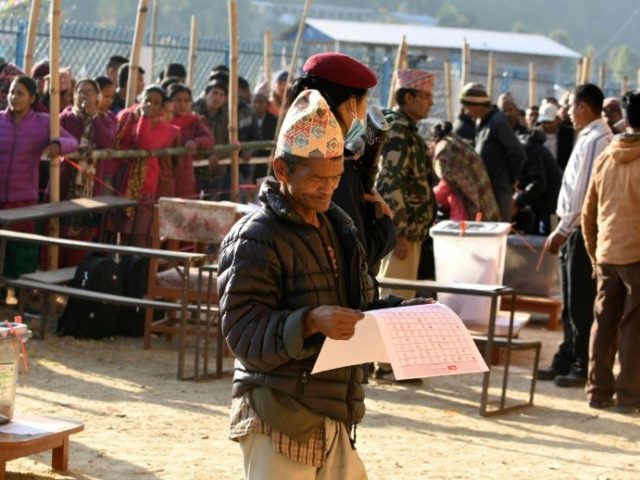This morning’s key headlines from GenerationalDynamics.com
- Communists score major election wins in Nepal, possibly moving country towards China
- Nepal reacts to India’s bungled meddling over the new constitution
Communists score major election wins in Nepal, possibly moving country towards China

Zhangmu in Tibet, in China, just across from the Nepal border (Bob Witlox/Flickr)
The country Nepal is a strip of land, about 500 miles long and 100 miles wide, that separates a part of the border between India from China’s Tibet. With China and India on the verge of a border war, Nepal becomes extremely important strategically to both India and China.
Nepal recently held elections under a new constitution adopted in 2015. These elections will elect 275 members to the House of Representatives and 550 representatives to the assemblies of the seven newly-created provinces.
The elections have been won overwhelmingly by a “Left Alliance” of two hyphenated communist parties – the Communist Party of Nepal-Unified Marxist-Leninist (UML) and Communist Party of Nepal-Maoist Center (MC). These two parties have been locked in adversarial conflict and rivalry for years, but they have put aside their differences in a marriage of convenience to form a governing coalition. The Left Alliance will control not only the national government, but also six of the seven provinces.
Analysts say that the emergence of the Left Alliance does not necessarily mean that Nepal’s voters prefer communism to democracy. Instead, the vote express a new nationalism which has three key components: the search for political stability and peace, the demand for fast and comprehensive development and assertion against India.
For centuries, Nepal was governed by a Hindu monarchy with close ties to India. In 2001, Crown Prince Dipendra got drunk at a party and gunned down the entire royal family, and then killed himself. Dipendra’s motive turned out to be that he had wanted to marry his girlfriend, Devyani Rana, but his parents had refused. This triggered a renewal of a Maoist insurgency that had begun in the 1990s.
This is Nepal’s first free election in a secular republic, replacing the monarchy with an elected government. My República (Nepal) and The Wire (India) and Al Jazeera
Nepal reacts to India’s bungled meddling over the new constitution
Nepal has long been one of the world’s poorest countries, and 2015 was a year with one major disaster after another.
Two massive earthquakes struck Nepal on April 25 and May 12, 2015. More than 8,800 people were killed, and 600,000 homes were flattened. Millions of people were left with inadequate food, clean water, and shelter. Nepal still has not recovered from that disaster.
The earthquake came at a time when the government was in a state of almost total paralysis, because the constitutional transition Hindu monarchy to a secular republic was in process, triggering massive demonstrations, especially by the Madhesis, a mostly Hindu ethnic group in Nepal’s Tarai region on the border with India.
The new constitution was adopted on September 17. On September 24, the Madhesis began massive demonstrations, blockading the truck traffic passing between India and Nepal. This was a disaster for Nepal’s economy, which depends on imports from India for many goods, including petroleum and cooking gas, forcing many manufacturers to shut down.
Nepal blamed India for the border blockade, saying that India’s prime minister Narendra Modi was using the blockade to force Nepal to eliminate clauses in the new constitution that the Madhesis claim discriminate against them. Some people say that the recent victory of the Left Alliance was a reaction to India’s bungling two years ago in handling the blockade.
Nepal media are debating whether the election results mean that Nepal is moving away from India towards China. China has been trying to improve its influence in Nepal since the removal of the Hindu monarchy, and so the victory of the Left Alliance represents a kind of victory. It also allows politicians, even those who favor India, to say that the Left victory is a victory for nationalism and independence from the “Indian bully.” However, the Madhesis and other Hindu ethnic groups form 40 percent of the population, and they would oppose choosing China over India.
Also, Nepal cannot go too far in alienating India, because of the economic dependences. Nepal is a landlocked country, and the only way to transfer goods to or from the Indian Ocean is through India and the port of Vishakhapatnam on the Bay of Bengal.
Realizing the alarm that many people feel over their victory, the Left Alliance has released a statement:
As per the directions made by the constitution of the Nepal, we will develop the relation with friendly nations especially the neighboring countries and the international unions and organizations on the basis of independent foreign policy.
The statement added, “We, the left power, are committed to form a stable government and fulfill the promises which we made before.” My República (Nepal) and ANI (India)
Related Articles
- Nepal’s fuel deal with China collapses, as India border blockade worsens (30-Nov-2015)
- Nepal turns to China as border tensions with India increase (08-Nov-2015)
- Violence continues for fourth day in Haiti (11-Dec-2010)
- Maoist rebels bringing chaos to Nepal and region (09-Apr-2006)
KEYS: Generational Dynamics, Nepal, India, China, Left Alliance, Communist Party of Nepal-Unified Marxist-Leninist, UML, Communist Party of Nepal-Maoist Center MC, Crown Prince Dipendra, Devyani Rana, Madhesis, Narendra Modi, Vishakhapatnam port
Permanent web link to this article
Receive daily World View columns by e-mail

COMMENTS
Please let us know if you're having issues with commenting.